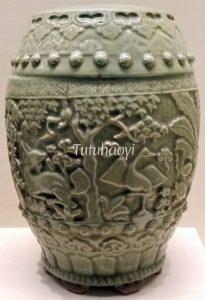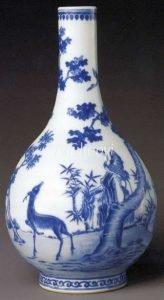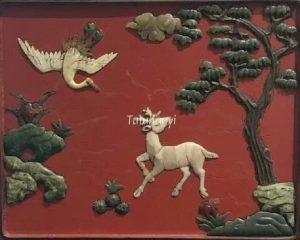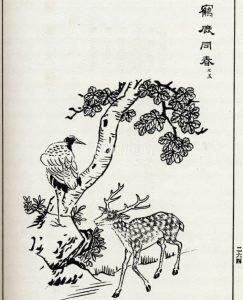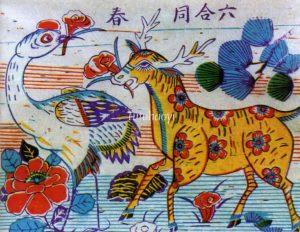May the whole universe prosper in eternal spring
六合同春
© Tutuhaoyi.com owns the copyright of the description content for the images attached. Quoting all or part of the description content on this page is permitted ONLY IF ‘Tutuhaoyi.com’ is clearly acknowledged anywhere your quote is produced unless stated otherwise. (本页描述内容版权归Tutuhaoyi.com所有,转发或引用需注明 “Tutuhaoyi.com”, 侵权必究, 已注开源信息的条目除外。)
Yang Shen (杨慎, 1488–1559), alias Sheng’an (升庵), is a literatus and poet in the Ming dynasty (1368–1644). He recorded in Volume Ninety-Four of Sheng’an Additional Works a folklore anecdote: ‘In the northern dialect, there is no difference in sound between the he 合 for “coming together” and the he 鹤 for “crane”. There are people who painted six cranes and a Chinese cedar tree to form a pun rebus design meaning “liu he tong chun (六合同春), i.e. May the whole universe prosper in eternal spring”.’ (杨慎《升庵外集》卷九十四:“北之语合鹤迥然不分,故有绘六鹤及椿树为图者,取六合同春之义”. ) The Chinese phrase ‘liu he 六鹤’ for ‘six cranes’ puns on the phrase ‘liu he 六合’ for ‘six directions’, i.e., heaven, earth, north, south, east, and west, namely, ‘the universe’. The Chinese cedar or mahogany tree, i.e., toona sinensis, is called ‘chun 椿’ tree in Chinese and is used as a pun on ‘chun 春’ for ‘the spring season’.
Unfortunately, there are no examples of this ingenious ancient design passed down. However, there is a related pun rebus design extant on ancient porcelain and other handcrafted art works. This design consists of three key elements: deer, crane, and the wu tong 梧桐 tree, or Chinese parasol tree. In some Chinese dialects, the combination of the Chinese characters ‘lu 鹿’ and ‘he 鹤’ for ‘deer and crane’ makes a pun on ‘liu he 六合’ for ‘six directions’ or ‘the universe’. The image of the wu tong 梧桐 tree, or Chinese parasol tree in the design cues the concept of ‘tong chun 同春’, meaning ‘sharing the spring season’. The pun rebus design appears as early as in the Ming dynasty on a Longquan celadon garden seat. As a culturally cherished picture, it also appears on a porcelain bottle vase and a table screen both crafted in the Qing dynasty (1644–1911).
The diligent Japanese scholar Nozaki Nobuchika 野崎诚近 collected this design in his pioneering volume on Chinese pun rebus pictures 吉祥図案解題: 支那風俗の一研究. His illustration clearly shows the three key elements that form the pun rebus. However, in the title of this picture, he literally put down Chinese characters ‘lu 鹿’ for ‘deer’ and ‘he 鹤’ for ‘crane’, instead of the concept ‘liu he 六合’ for ‘six directions’ or ‘the universe’, to which the two creatures were meant to refer.
Luckily enough, a related Qing-dynasty New Year print with both a deer and a crane on it is still in existence. On top of the picture, the Chinese phrase “liu he tong chun (六合同春), i.e. May the whole universe prosper in eternal spring” is printed verbatim. Although the careless print maker failed to include the wu tong 梧桐 tree, or Chinese parasol tree, in the design, it is evident that this was a popular auspicious theme in traditional China.
literature research: by Dr Yibin Ni
Fig 1: celadon seat with carved relief decoration, Longquan ware, Ming dynasty (1368–1644), courtesy of Palace Museum, Beijing
Fig 2: porcelain bottle vase with underglaze blue decoration, Qianlong period (1736–95), Qing dynasty, courtesy of Beijing Poly Auction, 05 Dec, 2010
Fig 3: lacquer screen inlayed with precious stones, Qing dynasty (1644–1911), private collection
Fig 4: illustration, Kisshō zuan kaidai : Shina fuzoku no ichi kenkyū by Nobuchika, Nozaki, Pl. 75, Tenjin: Chn̄goku Dosan Kōshi 1928 野崎誠近:《吉祥図案解題: 支那風俗の一研究》中國土產公司, 1928,第75图
Fig 5: colour New Year print (detail), 19th century, Wei County, Shandong province, China
